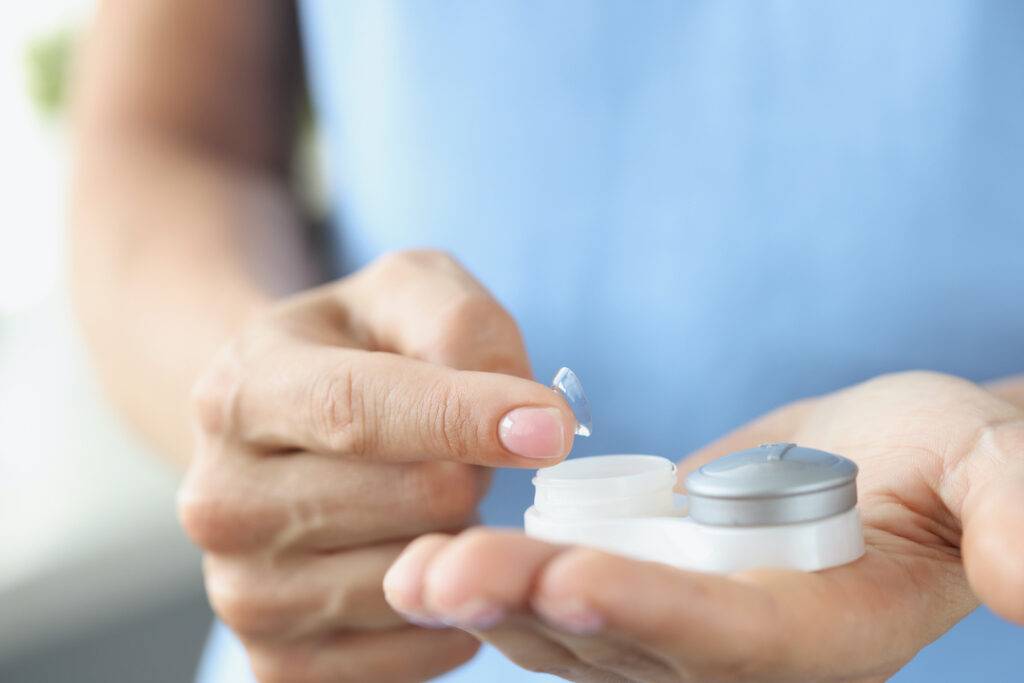Have questions about contact lenses for swimming? You’ve made it to the right place!
Ever try to open your eyes underwater? If you’re a vision-challenged swimmer, then you’ve probably attempted it. Suddenly, your vision resembles an abstract painting—blurry shapes and indistinct colors that leave you disoriented.
There are a lot of reasons people want soft lenses to see underwater, whether you’re training or simply want clear vision underwater. But hold on… is it safe to swim in contact lenses? Can microscopic monsters in the water hitch a ride into our eyes?
In this guide, we’re going to be learning about the risks of swimming with contacts and the ways that you can see clearly underwater without causing any unnecessary eye strain or damage
Ready to dive deeper? By reading on, not only will you discover how to pick suitable contacts for swimming, but you will also learn essential tips for keeping your eyes healthy. Trust the experts at Linneo to give you the full report on swimming with contact lenses. Before we get to the risk, it’s time to talk about how to keep your eyes healthy in aquatic environments. Looking for other ways to keep your eyes healthy? Consider an individual vision insurance plan!
Table of Contents
Can You Wear Contacts in the Pool?
Don’t make the mistake of wearing your contact lenses for swimming
When it comes to swimming, many folks with vision issues face a dilemma. They often question if they should still wear glasses or contact lenses in the pool or not.
Understanding this issue is critical because bodies of water can contain harmful microorganisms that cause corneal ulcers and eye infections. Wearing contacts while swimming increases the risk of corneal ulcers, abrasions, inflammation, and dry eye syndrome. In short, you should never swim with your contact lenses in, and there are currently no contact lenses for swimming on the market that would help reduce these risks.
Why Eye Health Matters in Aquatic Environments
Maintaining good hygiene habits when wearing contacts in aquatic environments is crucial. It’s essential to take eye drops to avoid serious infections like Acanthamoeba keratitis. This microscopic organism lives all around us—in soil, air, and water—but can be particularly dangerous if trapped against your eyes by contact lenses. The CDC reports several cases each year caused by improper contact lens care related to water exposure.
Recommendations from Eye Health Authorities
The American Optometric Association (AOA), along with other authorities such as the U.S. FDA, strongly advises against swimming with contact lenses.
Their recommendations are clear and direct—to an eye infection and prevent any eye issues, it’s best not to wear contacts while taking a dip in the pool or soaking in a hot tub.
Risks of Wearing Contact Lenses for Swimming
Many people don't realize that wearing contact lenses for swimming can pose significant risks

When you wear contacts in water, they quickly absorb it, trapping harmful bacteria and viruses against your eyes. This happens because contact lenses are like sponges, drawing in whatever is around them.
This absorption increases when we swim in natural bodies of water, such as lakes or oceans, where dangerous microorganisms reside. Additionally, many of these microorganisms aren’t killed by pool chemicals used to clean swimming pools. One notable culprit is Acanthamoeba keratitis—a severe infection caused by microscopic organisms commonly found in tap water and soil.
Symptoms may start subtly with redness or blurred vision but could escalate to pain and even permanent vision loss if not treated promptly.
If you decide to get near the water with your contacts on—or by accident—make sure to replace your contact lens case storage case frequently. This helps avoid cross-contamination from bacteria accumulated in daily disposable lenses over time.
Remember, your eye health isn’t something to take lightly—always prioritize safety before diving headfirst into those cool blue waves.
Alternatives to Contact Lenses for Swimming
Now that we know it best to avoid the water while wearing contacts, let’s look at some ways you can achieve clear vision underwater
Since it isn’t safe or recommended to swim with contact lenses, it’s time to take a look at some alternatives that can help you see clearly while you swim.
Prescription goggles, designed specifically for swimming, offer a safer and more convenient option than wearing contacts in water.
The major advantage is their ability to correct your vision while keeping your eyes safe from harmful bacteria found in pools or natural bodies of fresh water. Plus, no need to worry about losing them mid-swim.
While prescription goggles significantly reduce the risk compared to contact lenses, it’s still important to keep them clean and avoid touching them with dirty hands before use.
How to Choose the Best Prescription Goggles for Swimming
Need corrective lenses underwater? Ditch contact lenses for swimming in favor of prescription swimming goggles
If you wear prescription glasses or contact lenses, you are likely rightfully hesitant to jump in the water. Especially after we’ve gone over the potential dangers associated with wearing lenses underwater. Fortunately, prescription goggles for swimming can provide you with clear vision while keeping your eyes protected. Let’s take a look at the essential factors to consider when selecting the best prescription goggles for your swimming needs.
Get Your Prescription Right
Before you start shopping for prescription swimming goggles, it’s crucial to have an up-to-date prescription from your eye doctor.
Your prescription will include important details like your sphere (Sph) and cylinder (Cyl) values, which determine the strength of your corrective lenses. Double-check that your prescription is current to ensure you’re getting the most accurate swim goggles made for your vision needs.
Lens Prescription: More Than Just Numbers
Your lens prescription isn’t just about correcting blurry vision— it’s also crucial for comfort and ease of use. For example, if your contacts don’t fit well or rotate too much when blinking, they won’t provide clear and stable vision. So yes. Proper fitting is crucial to ensure comfort and clear vision.
You should ask questions during fittings to make sure everything feels good before committing to any one brand or style. Don’t forget that even after leaving the office, adjustments might be necessary until you find what works best
Choose the Right Lens Type
Prescription swimming goggles come with different lens types to cater to various vision conditions. Here are the most common options:
- Single Vision Lenses: These are suitable if you have a single vision condition, such as nearsightedness (myopia) or farsightedness (hyperopia).
- Bifocal Lenses: If you require different prescriptions for distance and reading (e.g., for checking a fitness tracker or reading a poolside book), bifocal lenses are a good choice.
- Progressive Lenses: Progressive lenses are multifocal and provide a seamless transition between different vision zones. They’re great for swimmers with multiple vision needs.
Lens Material Matters
The lens material you choose for your prescription swimming goggles can impact comfort, clarity, and durability. Common lens materials include:
- Polycarbonate: Known for its impact resistance, polycarbonate lenses are ideal for active swimmers and offer excellent protection.
- CR-39: These lenses are lighter and more affordable than polycarbonate but may not be as durable.
- High-Index Lenses: If you have a strong prescription, high-index lenses are thinner and more lightweight, making them a comfortable choice.
Comfort and Fit
Comfort is paramount when selecting prescription swimming goggles. Ensure that the goggles have a snug but not overly tight fit to prevent water from seeping in. Adjustable nose bridges and straps can help you achieve a customized fit.
Consider Additional Features
Some prescription goggles come with extra features that can enhance your swimming experience. These may include:
- Polarized Lenses: Reduce glare and improve visibility, especially in open water environments.
- Tinted Lenses: Tinted lenses can provide better visibility in bright outdoor conditions or add style to your swim.
- Quick-Adjust Straps: Make it easier to secure your goggles without the hassle of knots or clasps
Try Before You Buy
Nobody likes hiccups when it comes down to our sight, right? Even though we’d love everything to go smoothly, sometimes it just doesn’t. But don’t worry. Common issues like discomfort or shifting lenses can often be fixed with minor adjustments.
Remember: never hesitate to consult your eye care professional if you’re experiencing problems with your contacts. They’re the experts, after all.
What to Do if Your Contact Lenses are Exposed to Water
Don’t panic! Take these steps to ensure your eyes stay healthy after exposure

If your contact lenses come into contact with water while you’re swimming, it’s essential to take immediate action to protect your eye health.
Water, whether from pools, lakes, or oceans, can introduce a variety of contaminants and microorganisms that may lead to eye infections or discomfort. The first step is to remove your contact lenses immediately.
If you’re in a pool, rinse your eyes with fresh, clean water from a shower or sink, and then use lubricating eye drops to relieve any discomfort.
Do not use pool water to rinse your eyes, as it can contain chlorine and other chemicals that may exacerbate the problem. If you experience persistent irritation, redness, or any unusual symptoms, consult an eye care professional promptly.
To prevent such situations in the future, consider using prescription goggles or daily disposable contacts or contact lenses designed for water activities, as they can offer both vision correction and eye protection while swimming.
FAQs About Contact Lenses for Swimming
Can you wear contacts under goggles while swimming?
Yes, but it’s safer to wear goggles or use prescription goggles. If you must wear contacts, opt for daily disposables and remove them promptly after swimming.
Can you swim with hard contact lenses?
No, avoid swimming with any type of contact lenses. Hard and soft contact lenses are more likely to fall out in water and can trap harmful bacteria against the eye.
How can I swim with bad eyesight?
You have options like wearing prescription goggles or using corrective lens masks designed for underwater use. These give you crystal-clear vision without risking your eye health.
Can I put my contacts back in after swimming?
If they’re daily disposables—yes, a fresh pair, but only new ones. Never reuse a pair that’s been exposed to water, as this increases infection risk significantly.
Bear in mind the recommendations from health authorities like the American Optometric Association (AOA)— it’s best to wear contact lenses and avoid wearing contacts while submerged.
Think about alternatives such as prescription goggles that provide vision correction without exposing your eyes to potential harm. With the right pair of prescription goggles, you can see underwater without any of the associated risks!

